- Home
-
Research Groups
Division Groups
- Artificial Photosynthesis
- Catalysis: Reactivity & Structure
- Electrochemical Energy Storage
- Electron- and Photo-Induced Processes for Molecular Energy Conversion
- Neutrino and Nuclear Chemistry
- Surface Electrochemistry and Electrocatalysis
Associated Groups
- Catalysis for Alternative Fuels Production
- Nanostructured Interfaces for Catalysis
- Structure and Dynamics of Applied Nanomaterials
- People
- Operations
- News
- Events

Structure and Dynamics of Applied Nanomaterials
The SDAN Group has research efforts in the areas of:
- In situ/operando characterization, reactivity and design of nanoparticle catalysts,
- Structure, diffusion and optoelectronic properties of doped colloidal semiconductor quantum dots,
- Development of Machine Learning methods for X-ray absorption Spectroscopy
- Physico-chemical properties of nanoparticles,
- Mechanistic understanding of novel filtration materials,
- Methodology of catalyst characterization and design,
- Mechanisms of electromechanical activity in active piezo-, para-electrics and electrostrictors
- Supporting operations and training new users of Synchrotron Catalysis Consortium,
A brief description of these efforts is summarized below:
A neural network approach for structural characterization of nanocatalysts
Tracking the structure of heterogeneous catalysts under operando conditions remains a challenge due to the paucity of experimental techniques that can provide atomic-level information for catalytic metal species. We applied X-ray absorption spectroscopy (XANES and EXAFS) and supervised machine learning (SML) for determining the three-dimensional geometry of metal catalysts. Artificial neural network (NN) is used to unravel the hidden relationship between the XANES features and catalyst geometry. In the case of EXAFS, NN is used to obtained the radial distribution function directly from the spectra. Our approach allows one to solve the structure of a metal catalyst from its experimental XANES or EXAFS spectra. These applications are demonstrated by reconstructing the average size, shape and morphology of well-defined platinum nanoparticles and monitoring structural changes in bulk Fe during its structural phase transition from BCC to FCC upon heating. This method is applicable to the determination of nanomaterial structure in operando studies It also allows on-the-fly analysis, and is a promising approach for high-throughput and time-dependent studies
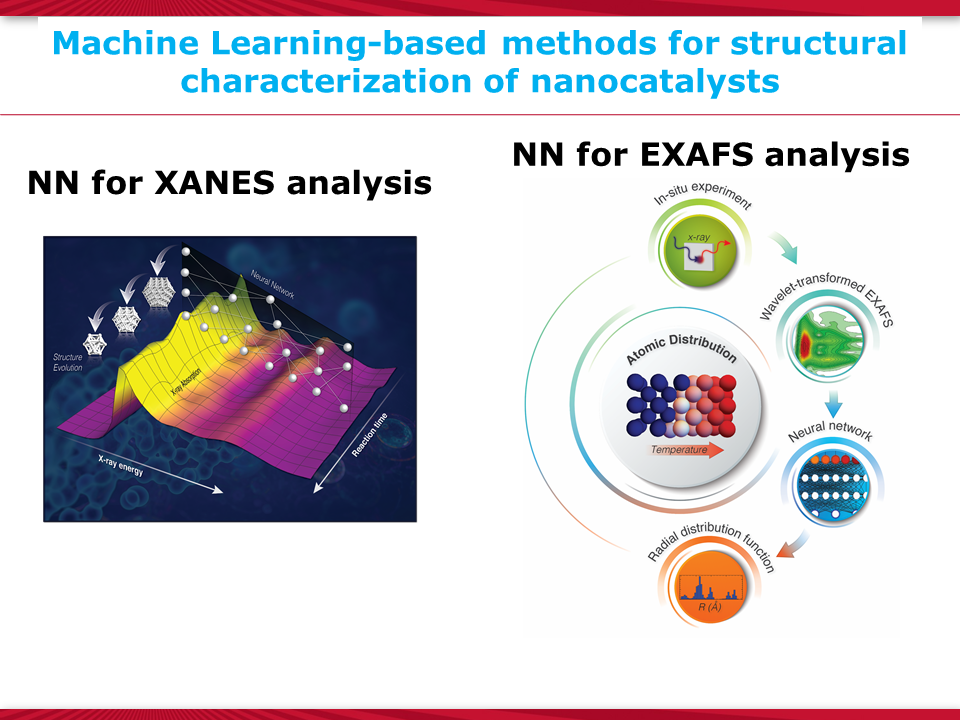
Intra-cluster Heterogeneity of Nanocatalysts
Uniqueness of structure, electronic and thermal properties of nanoparticles (NPs) of several nanometers in diameter affects strongly their physicochemical properties. For example we were able to explain our observation of negative thermal expansion in supported Pt NPs by complex interactions with support and multi-scale dynamic attributes of particles whose characteristic vibration periods are of the order of 100 fs and diffusion times of thousand times slower. Such anomalous behaviors introduce dynamic changes in the electronic structure and bonding and, hence, the details of barrier crossing in their applications to catalysis. The impact on catalytic activity is particularly dramatic because of the strong dependence of most commonly used catalytic descriptors on the metal-support interaction, bond strains and adsorbate coverage. In our work using inner shell X-ray spectroscopies (X-ray absorption fine structure, high energy resolution fluorescence detection, and resonant inelastic x-ray scattering), we discovered investigate relationships between metal-metal bond strain, effects of support and chemisorptions energy of adsorbates.
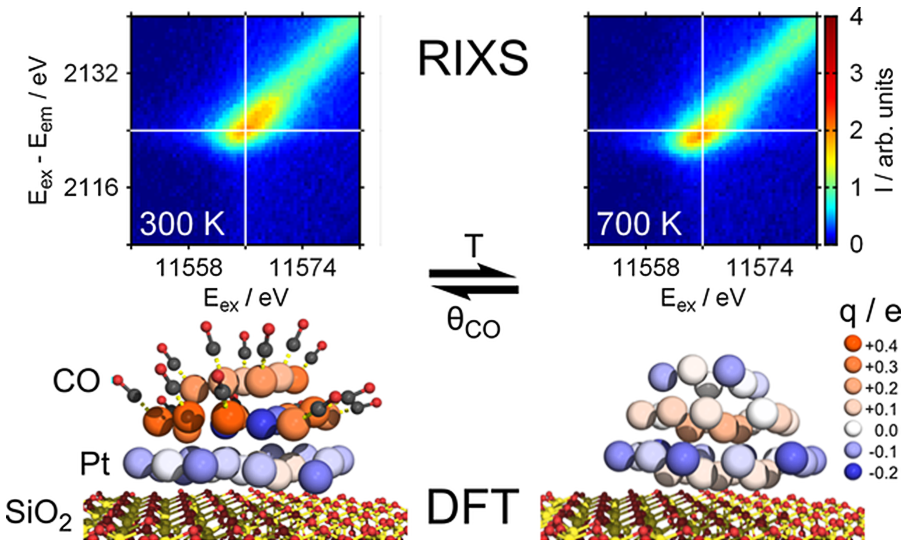
Perturbation of charge density and structure of silica supported Pt catalysts (as imaged by RIXS and modeled by DFT) in response to adsorbate (CO) coverage.
Study of Catalytic Mechanisms in Operando Conditions, Using Micro-reactors
To develop experimental basis and theoretical framework of thermodynamics in complex nanoscale systems, their many properties (e.g., surface free energy, chemical potential, adsorbate coverage) must be measured in the same thermodynamic state. Our group and collaborators have developed, and will continue to develop and use, in situ/operando experimental methodologies and techniques for such measurements. Among them are X-ray absorption and diffraction, UV-Vis. and Raman spectroscopies, all coupled with online product analysis, and all combined in the same experiment for interrogating catalysts at work. We have recently developed (together with our collaborator, E. Stach, from the CFN) a method of structural characterization that combines average (using X-rays) and local statistical (using electron microscopy) measurements of the same working catalytic system.
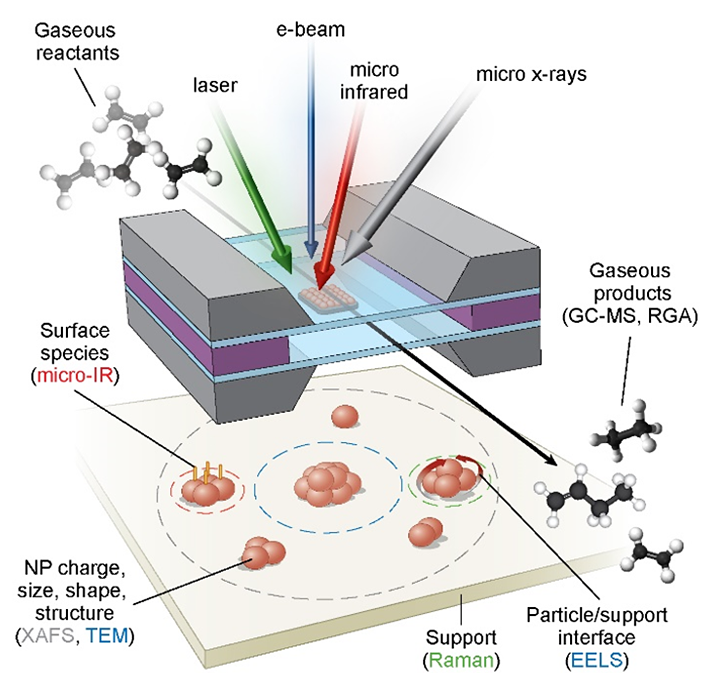
Correlative studies of catalytic mechanisms in operando conditions, using micro-reactors
Probing Active Species and Spectators by Differential Spectroscopy Methods
Another challenge to any nano-characterization methodology is the demand for high sensitivity to active species in a working catalyst. Such species are often in minority in real processes, be it a work involving catalysts with low loading, or a doped ionic conductor or electrostrictor with low concentration of vacancies, or a doped metal oxide featuring metal-insulator transition in dilute dopant limit, or a doped semiconductor quantum dot with new optoelectronic properties (all examples are from my current research. At the Synchrotron Catalysis Consortium at BNL, we have begun development and testing methods that enhance the sensitivity to active species. Among them are applications of pulsed methods in spectroscopy, such as modulation-excitation spectroscopy (MES), that we applied to phenomena at the solid-gas interface (such as in nanocatalysis) and in multi-component systems (such as electrostriction in doped cerium oxides).
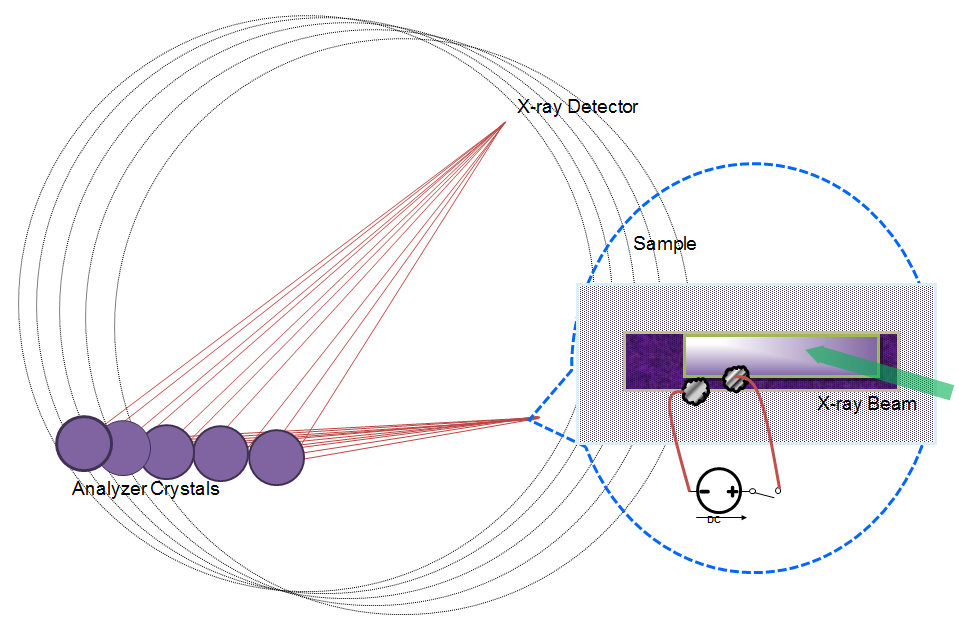
Investigating local origin of electrostriction in Gd-doped Cerium oxide by differential High Energy Resolution Fluorescence Detection (HERFD)
Structural analysis of dilute metal species using XANES modeling
To refine the local environments around metal impurities in a large variety of materials, we adopted ab initio X-ray absorption near edge structure (XANES). For instance, we employ the sensitivity of XANES spectra to the geometry of environment around absorbing atoms to reconstruct the 3D structure of bimetallic catalysts. That sensitivity allows us to create a library of suitable theoretical standards for many geometries of atomic placement of bimetallic species within the nanoparticles (e.g., sites in the core, on the surface) or in the precursor complexes, and subsequently use it for reconstructing the unknown geometries in real time and reaction conditions.
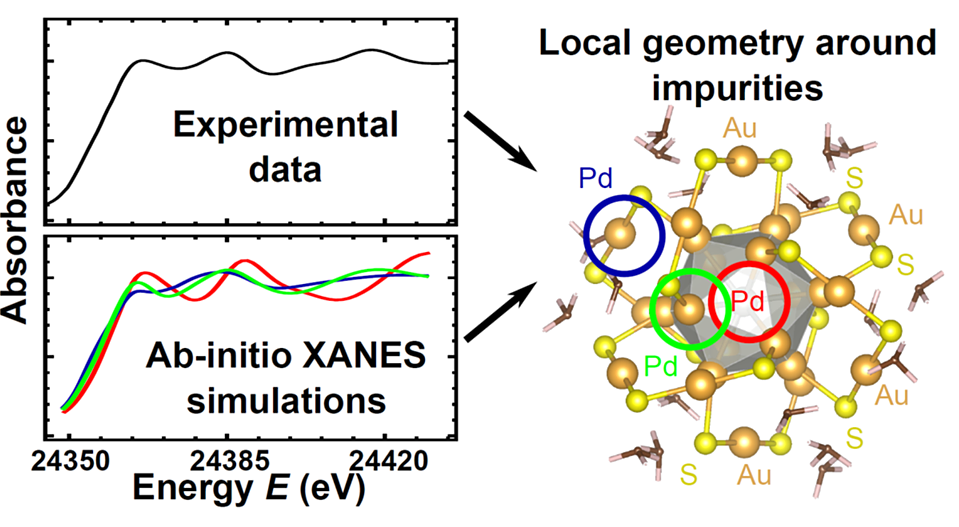
Normalized Pd K-edge XANES spectra for Au24Pd nanoparticle, shown on the right side: experimental data and results of ab-initio XANES simulations for three possible locations of Pd atom.




